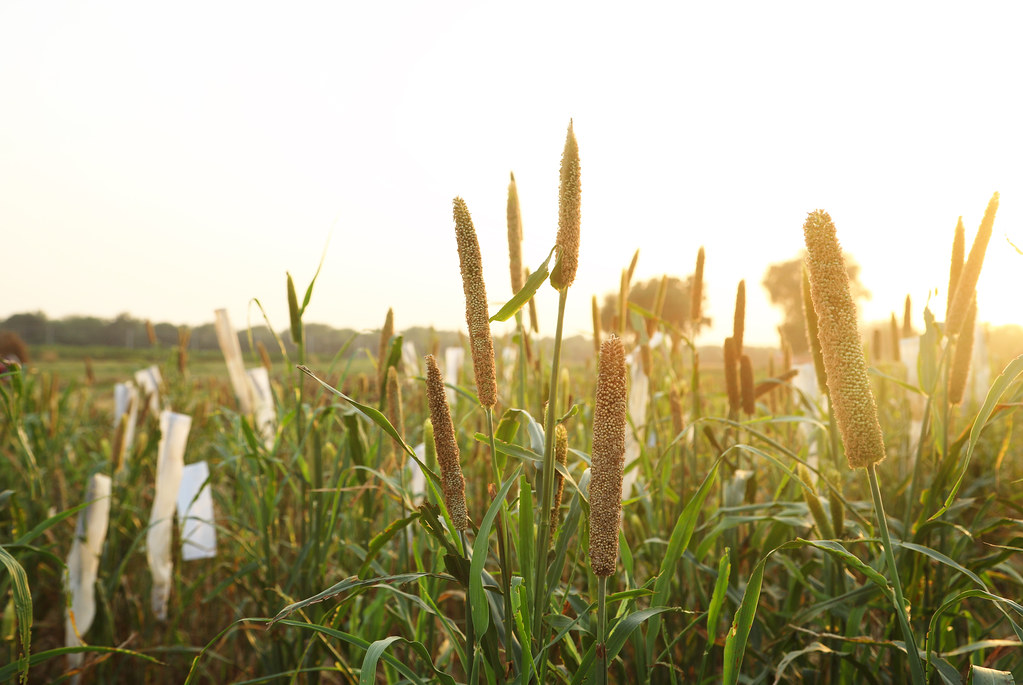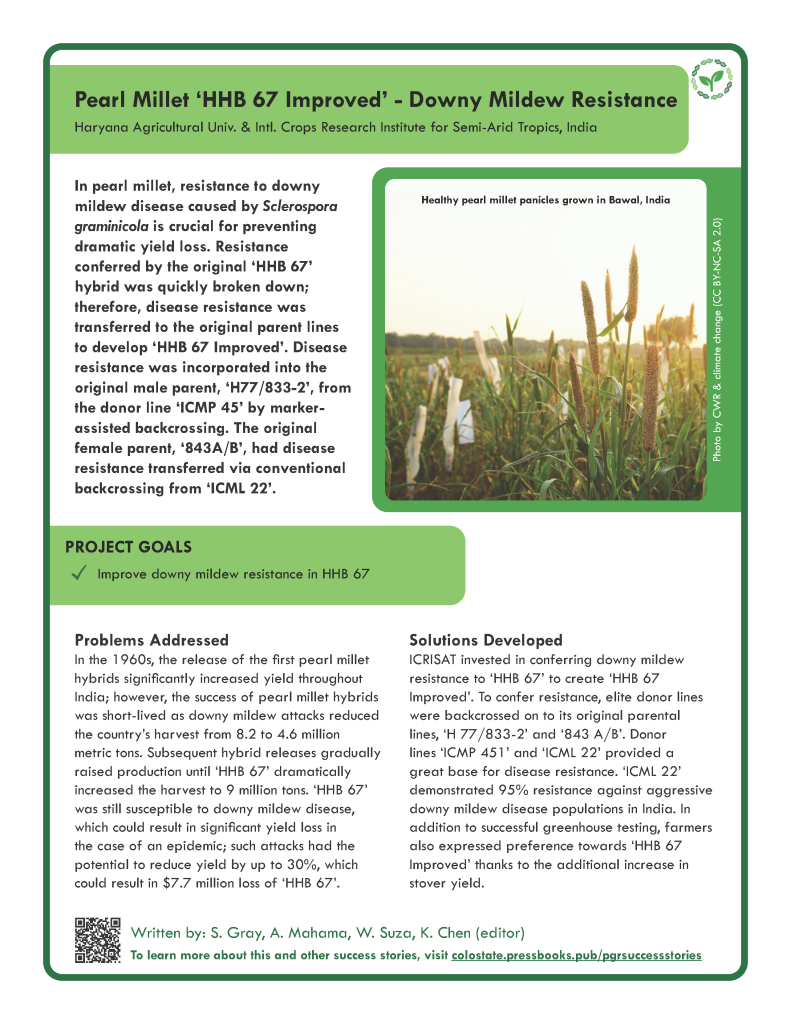Cereal Crops
Pearl Millet ‘HHB 67 Improved’ – Downy Mildew Resistance
THE IMPROVEMENT OF DOWNY MILDEW RESISTANCE IN PEARL MILLET (PENNISETUM GLAUCUM) HYBRID ‘HHB 67’
Stephen Gray; Anthony Mahama; and Walter Suza
Department of Agronomy, Iowa State University, Agronomy Hall 716 Farm House Ln, Ames, Iowa 50011.
Corresponding author: sjgray4@iastate.edu
OUTLINE
1. SUMMARY

Resistance to downy mildew disease caused by Sclerospora graminicola in pearl millet [Pennisetum glaucum (L.) R. Br.] is crucial due to dramatic yield loss that occurs as a result of downy mildew attacks. Resistance conferred by the original ‘HHB 67’ hybrid was quickly broken down. This led to the development of ‘HHB 67 Improved’, which was developed via marker-assisted and conventional backcrossing of disease resistance into original male and female parent lines. For the original male parent, line ‘H77/833-2’, disease resistance was conferred by marker-assisted selection from the donor line ‘ICMP 451’. The original female parent of HHB 67, line ‘843A/B’, had disease resistance transferred via conventional backcrossing from line ‘ICML 22’ at the International Crops Research Institute for Semi-Arid Tropics (ICRISAT) in India.
The goal was to improve downy mildew resistance in pearl millet hybrid HHB 67.
Download a printable fact sheet by clicking the image below.
2. PROBLEMS ADDRESSED
In the mid 1960’s the release of the first pearl millet hybrids ‘HB1’, ‘HB2’, and ‘HB3’ led to a significant increase in yield throughout India. In 1970-1971, with less than 20% of land being planted to HB3, India recorded a record pearl millet harvest of 8.2 million metric tons. However, this success was short lived as the following year a downy mildew attack reduced the harvest to 4.6 million metric tons (Singh, 1995). Subsequent hybrid releases with improved adaptability to growing conditions within India gradually raised production back to 6 million metric tons; however, disease resistance of these improved hybrids would fade quickly (Pray & Nagarajan, 2009). As a result, the success of pearl millet hybrids is short-lived and breeding efforts moved quickly to ensure the stability of pearl millet production.
The release of the popular pearl millet hybrid ‘HHB 67’, in the 1990’s provided farmers with the ability to capture high yields in a short duration providing the opportunity to double crop. While ‘HHB 67’ would raise production levels to 9 million tons, downy mildew disease would still inhibit ‘HHB 67’ from realizing maximum yield potential (Pray & Nagarajan, 2009). As a result, an emphasis was placed on transferring downy mildew disease resistance into ‘HHB 67’.
3. SOLUTIONS DEVELOPED

In order to confer resistance to ‘HHB 67’ elite donor lines ‘ICMP 451’ and ‘ICML 22’ were backcrossed onto parental lines ‘H 77/833-2’ and ‘843 A/B’ (Hash et al., 2006). Utilizing donor lines ‘ICMP 451’ and ‘ICML 22’ provided a great base for disease resistance; for example, ‘ICML 22’ demonstrated 95% resistance against aggressive downy mildew disease populations in India (Singh, 1995). To confer resistance to the male parent ‘H 77/833-2’ marker assisted backcrossing was employed to improve the efficiency of breeding. Marker assisted backcrossing enabled the development of a disease resistant parental line in slightly over three years (Hash et al., 2006). However, conventional backcrossing was utilized to confer resistance to the female parent ‘843 A/B’ which made the process more time consuming. Following the backcross process, the resistance to downy mildew disease was confirmed with greenhouse testing (Hash et al., 2006). Results from field trials were also promising as farmers expressed preference towards ‘HHB 67 Improved’, which in addition to offering downy mildew resistance, also displayed an increase in stover yield (Hash et al., 2006).
Collaborators involved in developing solution:
- Haryana Agricultural University, Hisar, Haryana, India
- International Crops Research Institute for Semi-Arid Tropics (ICRISAT), Patancheru, Hyderabad, Telangana, India
4. IMPACT
A downy mildew attack has the potential to reduce pearl millet yield by up to 30 percent (Hash et al., 2006). A 30 percent reduction in yield would result in $7.7 million loss of ‘HHB 67’. Not only has ‘HHB 67 Improved’ reduced the risk of such an economic impact, but at the time of release was estimated to produce an additional annual return of $2.6 million due to its yield advantage over the existing cultivar (Pray & Nagarajan, 2009).
5. GERMPLASM
The germplasm used to improve ‘HHB 67’ was sourced from genebank accessions and breeding lines:
‘IMCP 451’ (PI 572307), ‘ICML 22’ (PI 572474), ‘H77/833-2’, ‘843 A/B’

6. REFERENCES
Hash CT, Sharma A, Kolesnikova-Allen MA, Singh SD, Thakur RP, Bhasker Raj AG, Ratnaji Rao MNV, Nijhawan DC, Beniwal CR, Sagar P, Yadav HP, Yadav YP, Srikant, Bhatnagar SK, Khairwal IS, Howarth CJ, Cavan GP, Gale MD, Liu C, Devos KM, Breese WA, Witcombe JR. 2006. Teamwork delivers biotechnology products to Indian small-holder crop-livestock producers: Pearl millet hybrid “HHB 67 Improved” enters seed delivery pipeline. Journal of SAT Agricultural Research 2:1-3. https://research.bangor.ac.uk/portal/en/researchoutputs/teamwork-delivers-biotechnology-products-to-indian-smallholder-croplivestock-producers-pearl-millet-hybrid-hhb-67-improved-enters-seed-delivery-pipeline(7c59885c-0726-4898-8d04-561cf8f192f4).html
Singh SD. 1995. Downy mildew of pearl millet. Plant Disease 79:545-550. https://doi.org/10.1094/PD-79-0545
Pray CE, Nagarajan L. 2009. Pearl millet and sorghum improvement in India. IFPRI Discussion Paper 00919. International Food Policy Research Institute. http://www.ifpri.org/publication/pearl-millet-and-sorghum-improvement-india
7. CHAPTER INFORMATION
Citation: Gray S, Mahama A, Suza W. 2022. Pearl Millet ‘HHB 67 Improved’ – Downy Mildew Resistance. In: Volk GM, Chen K, Byrne P (Eds.) Plant Genetic Resources: Success Stories. Fort Collins, Colorado: Colorado State University. Date accessed. Available from https://colostate.pressbooks.pub/pgrsuccessstories/chapter/pearl-millet-hhb-67-improved-downy-mildew-resistance/
Content originally submitted: February 23, 2022
Date of publication: July 2022
USDA is an equal opportunity provider, employer, and lender. Mention of trade names or commercial products in this article is solely for the purpose of providing specific information and does not imply recommendation or endorsement by the U.S. Department of Agriculture.


